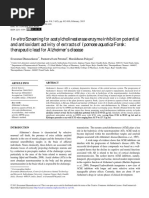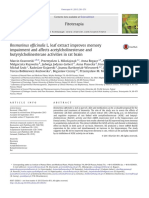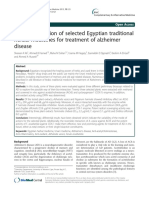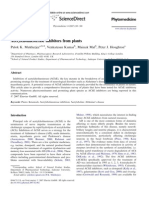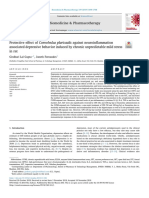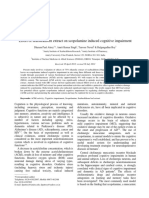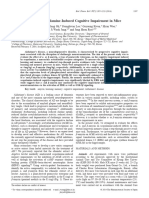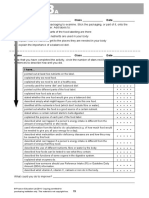Ic50 Piperin PDF
Ic50 Piperin PDF
Uploaded by
Desi PermatasariCopyright:
Available Formats
Ic50 Piperin PDF
Ic50 Piperin PDF
Uploaded by
Desi PermatasariOriginal Title
Copyright
Available Formats
Share this document
Did you find this document useful?
Is this content inappropriate?
Copyright:
Available Formats
Ic50 Piperin PDF
Ic50 Piperin PDF
Uploaded by
Desi PermatasariCopyright:
Available Formats
Okello et al., IJPSR, 2015; Vol. 6(9): 3726-3732.
E-ISSN: 0975-8232; P-ISSN: 2320-5148
IJPSR (2015), Vol. 6, Issue 9 (Research Article)
Received on 08 October, 2014; received in revised form, 28 July, 2015; accepted, 22 August, 2015; published 01 September, 2015
IN-VITRO ANTI-CHOLINESTERASE ACTIVITIES BY PIPERINE, AN ALKALOID FROM
THE SPICE FAMILY PIPERACEAE
E. J. Okello*, A. Coleman and C. J. Seal
Human Nutrition Research Centre, School of Agriculture, Food and Rural Development, Faculty of
Science and Engineering, Newcastle University, Newcastle upon Tyne, NE1 7RU, United Kingdom.
Keywords: ABSTRACT: The alkaloid piperine from the spice family Piperaceae has been reported to
possess poly-pharmacological activities including anti-depressant and cognitive enhancing
Piperine, Acetylcholinesterase, effects. It has been suggested that its neurocognitive benefits may be via its activity on the
Butyrylcholinesterase, Kinetics of cholinergic system, particularly on the enzyme acetylcholinesterase (AChE), a
Inhibition pharmacological target for neurodegenerative disease such as Alzheimer’s disease (AD). The
paucity of information on the potential mechanism of inhibition of acetylcholinesterase and
Correspondence to Author:
butyrylcholinesterase (BuChE), also a primary target for drug development for the treatment
Dr. Edward J. Okello
of AD, prompted this in vitro investigation. Dose-dependent inhibition of AChE and BuChE
Human Nutrition Research Centre, by piperine was determined using a modified classic colorimetric method of Ellman. Kinetics
School of Agriculture, Food and Rural of inhibition was determined by Lineweaver-Burk methods. Piperine inhibited both AChE and
Development, Faculty of Science and BuChE in a concentration dependent manner with IC50 values of 0.12 mM and 0.067mM,
Engineering, Newcastle University, respectively. Piperine exhibited a higher selectivity towards BuChE with a BuChE/AChE ratio
Newcastle upon Tyne, NE1 7RU, United of 0.56mM. Kinetic values for AChE classify piperine as a competitive inhibitor whereas the
Kingdom . values for BuChE classify it as a mixed inhibitor. Compared to galanthamine (a mixed
competitive non-competitive AChEinhibitor, IC50 of 1.068 nmol/ml under similar assay
E-mail: Edward.Okello@ncl.ac.uk conditions) we conclude that although the AChE inhibition by piperine is not as potent as that
of galanthamine, in addition to its known antioxidant and anti-inflammatory activities,
piperine could provide a novel poly-pharmacological lead of potential benefit for the
symptomatic treatment of AD and therefore warrants further investigation.
INTRODUCTION: Alzheimer’s disease (AD) is However, acetylcholinesterase inhibitors (AChEIs)
generally recognised as the most prevalent form of have become the mainstay for the symptomatic
dementia. It is an irreversible and progressive treatment of AD. AChEI drugs approved in the US
disease which destroys memory and cognitive skills and UK are: donepezil (Aricept®), rivastigmine
and eventually leads to death. 1 AD is a multi- (Exelon®) and galantamine (Reminyl®). In
aetiology disorder. Risk factors for AD include Europe, availability differs from country to
non-modifiable factors such as age and genetics, as country. The general mechanism of AChEI is to
well as modifiable factors such as dietary and increase the brain availability of the
lifestyle choices. 2 The current pharmacological neurotransmitter acetylcholine (ACh) through the
options available for the treatment of AD include inhibition of the enzyme acetylcholinesterase
cholinesterase inhibition, glutamate receptor (AChE) that plays a role in its hydrolysis. 3
modulation, anti-oxidants and anti-inflammatory Inhibiting AChE prolongs the time ACh molecules
agents. 3 remain in the synaptic cleft, to combine with
muscarinic receptors thus enhancing cholinergic
QUICK RESPONSE CODE neurotransmission.3
DOI:
10.13040/IJPSR.0975-8232.6(9).3726-32
Two types of cholinesterases exist; AChE, which
Article can be accessed online on:
selectively hydrolyses ACh, and
www.ijpsr.com butyrylcholinesterase (BuChE), which hydrolyses
other choline esters in addition to Ach. 3 BuChE is
DOI link: http://dx.doi.org/10.13040/IJPSR.0975-8232.6(9).3726-32 present in all human and mouse tissues, and is more
International Journal of Pharmaceutical Sciences and Research 3726
Okello et al., IJPSR, 2015; Vol. 6(9): 3726-3732. E-ISSN: 0975-8232; P-ISSN: 2320-5148
abundant than AChE in all body tissues except the O
brain. People who have no BChE activity due to a
genetic variation are healthy, which has led to the O
hypothesis that BChE has no physiological
N
function. 4 Over the course of AD however, AChE
activity decreases while BuChE activity stabilizes O
and even increases. Xie and co-workers 5 have FIG.1: CHEMICAL STRUCTURE OF PIPERINE
shown that cholinergic pathways lacking AChE are
sensitive to the toxic effect of BuChE selective MATERIALS AND METHODS:
inhibitors. These data suggest that BuChE may act Chemicals/reagents:
as a compensatory mechanism for Ach metabolism Acetylcholinesterase (EC 3.1.1.7) from
and support the potential of BuChE as a suitable Electrophorus electricus – homologous to human,
target for the treatment of AD. acetylthiocholine iodide (ATChI),
butyrylcholinesterase (EC 3.1.1.8) from equine
Black pepper (Piper nigrum) is the most widely serum, butyrylthiocholine (BTCh I), 5:5-dithiobis-
used among spices and belongs to the family 2-nitrobenzoic acid (DTNB) sodium bicarbonate
Piperaceae, cultivated for its fruit (berries) that are and Piperine (97% purity) (P49007) were
dried and used as a food seasoning. The spiciness purchased from Sigma Chemical Co., UK.
of the pepper compound is due to the nitrogenous
alkaloid substance piperine (1-piperoylpiperidine) Acetylcholinesterase activity:
(Fig.1), found both in the outer layer and seed Assessment of AChE inhibition was carried out
inside the fruit berries. Piperine is present in black using a calorimetric method of Ellman, et al.13 as
pepper (P.nigrum), long pepper (P. longum) and modified by Okello et al.14 A typical run consisted
other piper spices (Family: Piperaceae). 6 of 5 µL of AChE solution, at a final assay
concentration of 0.03 U/ml; 20 µL of 0.1M
Piperine, as seen in the historic remedies, is the phosphate buffer pH 8; 5 µl of DTNB, at a final
vital compound that exerts antipyretic and anti- concentration of 0.3 mM prepared in 0.1 M
inflammatory properties for medicinal uses. Other phosphate buffer pH 7 with 0.12 M of sodium
biological effects that piperine possess are; bicarbonate; and 5 µl of a piperine extract solution
analgesic 7, anticonvulsant 8, anti-ulcer 9, in 95% ethanol (EtOH). The reactants were mixed
antidepressant 10, cognitive enhancing 6, 11, in a 96-well, flat bottom polystyrene microtitre
cytoprotective and anti-oxidant. 12 The antioxidant plate. The mixture was shaken and pre-incubated at
properties in piperine have also been linked to 30oC for 10 minutes. The reaction was initiated by
improvements in cognitive function. In one study adding 5µl of ATChI at a final concentration of 0.5
11
, piperine was administered to Wistar male rats, at mM. Each sample was assayed in triplicate. The
doses ranging from 5, 10 and 20 mg/kg/day orally wells were again shaken before incubation at 30oC
for 4 weeks and the neuropharmacological activity for 10minutes. As a control 5 µl of the extract
was determined after single, 1, 2, 3 and 4 weeks of solution was replaced with 5 µl of 95% ethanol.
treatment.
The control was also assayed in a triplicate. To
The results showed that across the entire dosage monitor the non-enzymatic hydrolysis in the
range piperine possessed anti-depression-like reaction mixture, a blank consisting of 5 µl buffer
activity and a cognitive enhancing effect during the pH 8 replaced the AChE enzyme and 5 µlbuffer,
entire treatment duration. Although the precise pH 8 replaced the piperine solution. A kinetic run
mechanism is unknown, it was suggested that it absorbance at 405nm was measured on a Thermo
might be through the inhibition of lipid Labsystems Multiskan (Ascent software version
peroxidation and the acetylcholinesterase enzyme 2.6) 96-well plate reader for a period of 16 minutes
and that further studies were essential to understand at 30oC. The first 6 minutes were maintenance time
the precise mechanism of piperine’s activity 6, for problems reported by 15, 16, 17 that EtOH
hence the objective of this in vitro study. prevented inhibition of E. electricus AChE. Using a
low concentration of 1.2% EtOH in the assay and
International Journal of Pharmaceutical Sciences and Research 3727
Okello et al., IJPSR, 2015; Vol. 6(9): 3726-3732. E-ISSN: 0975-8232; P-ISSN: 2320-5148
maintaining the mixed reagents in the plate for an equation obtained from the log inhibition curve was
extra 6 minutes prevented this inhibition. 0.067mM. There was a difference in efficiency
between the two enzymes with piperine inhibiting
Butyrylcholinesterase activity: BuChE 47% more effectively than AChE at the
Assessment of BuChE inhibition was performed as same concentration; despite AChE reaching 100%
described above, with the exception of 5µlBuChE maximum inhibition and BuChE reaching 67%
replacing AChE and 5µlBTChI replacing ATChI. maximum inhibition. The ratio between the IC50
values is 0.56mM, of which a higher ratio would
Determination of dose response curve and have supported a higher selectivity for the AChE
kinetic parameters: enzyme.
The concentration of piperine that inhibited the
hydrolysis of substrate by 50% (IC50) was
determined by monitoring the effect of various 120
concentrations (0.03125 to 0.5mM). The per cent
inhibition of AChE and BuChE was calculated 100
using the following formula:
80
((Control (abs/min) – Piperine concentration
Inhibition [%]
(abs/min))/ control (abs/min)) * 100 = % inhibition. 60
Each concentration was run equivalent to n=6. 40
Dose-response curves were fitted to the data points
using Microsoft Excel software and Sigma Plot 11. 20
The IC50 value was calculated from the standard
curve equations using Sigma Plot 11. For inhibition 0
0.0 0.1 0.2 0.3 0.4 0.5 0.6
kinetic studies, the serial dilutions of the piperine Concentration [mM]
were pre-incubated with different substrate FIG.2: DOSE-DEPENDENT INHIBITION OF AChE BY
concentrations ranging from (0.0625 mM to 0.5 PIPERINE
mM). Piperine concentration of 0.0625 mM and
0.125 mM were chosen for the kinetics studies as
70
they were concentrations similar to the specific
BuChE and AChEIC50 values respectively. The 65
data for substrate kinetics were analysed using the
Lineweaver-Burk models for the determination of 60
Km and Vmax constants.
Inhibition [%]
55
RESULTS: 50
Effect of piperine on AChE and BuChE activity:
45
Analysis of data showed that piperine inhibited
AChE activity in a concentration dependent manner 40
(Fig.2). The maximum inhibition (100%) was
35
observed at the final assay concentration of 0.5 0.0 0.1 0.2 0.3 0.4 0.5 0.6
mM. The IC50 value calculated from the equation Conentration [mM]
obtained from the log inhibition curve was FIG.3: DOSE-DEPENDENT INHIBITION OF BuChE BY
0.12mM. This contrast with an IC50 value of 1.068 PIPERINE
nmol/ml for galanthamine, as previously
determined under identical assay conditions. 18 Determination of the kinetic profile of AChE
Piperine also exhibited a concentration dependent and BuChE against piperine:
inhibition of BuChE activity (Fig. 3), maximum The mechanism by which piperine inhibited the
inhibition (67%) was observed at the final assay enzymes AChE and BuChE was investigated using
concentration of 0.5 mM. The IC50 value from the the Lineweaver-Burk plots (Figures 4 & 5) and
International Journal of Pharmaceutical Sciences and Research 3728
Okello et al., IJPSR, 2015; Vol. 6(9): 3726-3732. E-ISSN: 0975-8232; P-ISSN: 2320-5148
Lineweaver-Burk constants (Table 1a and 1b). The as a mixed-inhibitor; where the Vmax values are
control (no piperine), 0.0625mM and 0.125 mM variable whereas the Km values increase. Compared
concentrations were used. The kinetic values for to galanthamine (a mixed competitive non-
AChE classified piperine as a competitive inhibitor; competitive inhibitor, piperine is not as potent as
where the Vmax values remained more or less this positive reference (IC50 of 1.068 nM/ml) as
constant while the Km values increased. However, previously tested under the same assay conditions.
18
the kinetic values for BuChE classified piperine’s
FIG.4: LINEWEAVER-BURK PLOT FOR AChE inhibition(● No piperine, Piperine 0.0625 mM)
FIG. 5: LINEWEAVER-BURK PLOT FOR BuChE inhibition (● No piperine, Piperine 0.125mM)
TABLE 1a: KINETIC CONSTANTS FOR AChE
Kinetic Constants
1 -1
/Vmax[mM/min] Vmax[mM/min] /Km [mM] Km [mM]
No piperine 70.652 0.014 6.19 0.16
Piperine 0.0625 mM 67.633 0.015 2.41 0.41
TABLE 1 b: KINETIC CONSTANTS FOR BuChE
Kinetic Constants
1 -1
/Vmax[mM/min] Vmax[mM/min] /Km [mM] Km [mM]
No piperine 50.678 0.020 11.01 0.09
Piperine 0.125 mM 8.45 0.118 0.13 7.47
DISCUSSION: Previous studies on piperine have further research was essential in order to
used animal models to assess the protective 6 and understand the precise inhibitory mechanism
11
cognitive enhancing effects against piperine exhibits against AChE and BuChE. This
neurodegeneration and cognitive deficit. However study therefore focussed on identifying the
International Journal of Pharmaceutical Sciences and Research 3729
Okello et al., IJPSR, 2015; Vol. 6(9): 3726-3732. E-ISSN: 0975-8232; P-ISSN: 2320-5148
cholinesterase inhibitory property of piperine via glial and BuChE-dependent acting within
kinetic study. Our study demonstrated that piperine conditions of decreased AChE activity such as in
exhibited anti-cholinesterase activity in a dose the Alzheimer’s disease brain. Two pools show
dependent manner. Furthermore, analyses of the different kinetic properties with regard to
Lineweaver-Burk kinetics showed that piperine regulation of brain ACh and can be separated by
followed a competitive inhibition pattern for AChE selective inhibitors.24 In the absence of AChE,
and mixed-inhibition for BuChE. There was a BuChE can hydrolyse ACh and potentially
higher affinity for BuChE with the IC50 value over substitute for AChE without producing peripheral
50 fold that for AChE inhibition. This is in or central cholinergic side effects. Considering the
contrast to galanthamine which has a 50 fold more drastic decrease in AChE activity taking place in
selective inhibition for AChE over BuChE. 19 the brain and the large pool of BuChE still
available both in glia and neurons, it may not
The proportion of the two enzymes, AChE and institute an advantage for a cholinesterase inhibitor
BuChE, present in the human brain are strongly to be selective for AChE. In contrast, a good
altered during the course of Alzheimer’s disease. In balance between AChE and BuChE inhibition
the cortex AChE activity decreases progressively to should result in higher therapeutic efficacy.22
10-15% of normal values, while BuChE activity is
unchanged or even increased by 20%. This may be Compounds with preferential cholinergic activity
the consequence of a combination of an could potentially be used therapeutically according
accumulation of BuChE in neuritic plaques and of to the severity of Alzheimer’s disease. Dual-
reactive gliosis.20 Given the close spatial cholinergic inhibitors are appropriate for a mild
relationship between glial cell protoplasm and stage of the disease where the Km of ACh is low
synaptic gap, it is likely that extracellularly- enough to keep BuChE inactivated.26
diffusing ACh may come in contact with glial
BuChE and be effectively hydrolysed as a The present knowledge of the molecular
result.21An important feature distinguishing BuChE configuration of the two enzymes would allow
from AChE is the enzymes kinetics toward researchers to design compounds possessing well-
concentrations of ACh. An excess of this substrate balanced AChE-BuChE specificity, high central
(µM) will inhibit only AChE but not BuChE. nerve system (CNS) penetration and low peripheral
Consequently, because of the difference in Km of and central cholinergic toxicity. Some of the
the two enzymes, glial BuChE is less efficient in second generation cholinesterase inhibitors have
hydrolysing ACh at low substrate concentrations demonstrated some of the advantages of these
(sub-µM) than neuronal AChE.22 The mechanism characteristics.22 Comparing this study’s findings
of inhibition caused by the excess of substrate has with the current literature on approved
been clarified.23 cholinesterase inhibitors; piperine evidently inhibits
both cholinergic enzymes and has an added affinity
Comparing the synaptic function between the two for BuChE, which is seemingly a pertinent
enzymes has shown variations between studies. An characteristic to have for higher therapeutic
extensive investigation found that AChE inhibition efficiency.
was more efficient than BuChE in elevating
cortical ACh using a non-selective inhibitor Research findings have revealed piperine to exhibit
compound eptastigmine. 24 Interestingly when a range of pharmacological effects, particularly
comparing these results against a BuChE specific with neurodegenerative diseases like Alzheimer’s.
inhibitor MF 8622, a high elevation of ACh similar A study by Chonpathompikunlert et al.6 infused
to that of eptastigmine, without the typical piperine at doses 5, 10, 20 mg/kg/body weight for 3
cholinergic side effects was demonstrated.25 The weeks bilaterally via intracerebro ventricular route
results of these experiments support the concept of as a bypassing strategy into the CNS. The findings
two pools of functional cholinesterases in the brain, were significantly improved spatial memory and
one neuronal and AChE-dependent acting mainly neurodegeneration, however there was a lack of
within physiological conditions and one mainly dose response relationship of piperine and AChE,
International Journal of Pharmaceutical Sciences and Research 3730
Okello et al., IJPSR, 2015; Vol. 6(9): 3726-3732. E-ISSN: 0975-8232; P-ISSN: 2320-5148
indicating the dose range was too high, therefore a 3. Lleό A: Current therapeutic options for Alzheimer’s
disease. Curr Genomics2007; 8: 550-558.
saturation effect was observed. A more recent 4. Duysen EG, Li B, Darvesh S, Lockridge O: Sensitivity of
investigation into the antidepressant and cognitive butyrylcholinesterase knockout mice to (-)-huperzine A
effects of piperine-encapsulated liposomes (PL) and donepezil suggests humans with butyrylcholinesterase
deficiency may not tolerate these Alzheimer’s disease
employed a randomly assigned oral dose of 5 drugs and indicatesbutyrylcholinesterase function in
mg/kg/body weight or an intranasal administration neurotransmission. Toxicology2007; 233: 60-69.
of 48 ng/kg/body weight in male Wister rats for 14 5. Xie WH, Stribley JA, Chatonnet A, Wilder PJ, Rizzino A,
McComb RD, Taylor P, Hinrichs SH, Locridge O:
days. 27 Postnatal developmental delay and supersensitivity to
organophosphate in gene-targeted mice lacking
The results showed a 60% efficiency of PL when acetylcholinesterase.J PharmacolExpTher2000; 293: 896-
902.
administered intra-nasally, delivering piperine to 6. Chonpathompikunlert P, Wattanathorn J, Muchimapura S:
the hippocampus at a faster rate and higher extent Piperine, the main alkaloid of Thai black pepper protects
than oral does. Intranasal delivery of piperine from against neurodegeneration and cognitive impairment in
animal model of cognitive deficit like condition of
the liposomes could therefore reduce the dose of Alzheimer’s disease. Food ChemToxicol2010; 48: 798-
piperine intake while giving similar cognitive and 802.
antidepressant effects as the oral dosage.27 The 7. Gupta SK, Bansal P, Bhardwaj RK, Velpandian T:
Comparative antinociceptive, anti-inflammatory and
various routes of administration shown by these toxicity profile of nimesulide and piperine combination.
studies, has provided substantial research and Pharmacol Res2000; 41: 657-662.
findings toward the development and 8. D́hooge R , Pei YQ, Raes A, Lebrun P, van Bogaert PP,
DeDeyn PP: Anticonvulsant activity of piperine on
implementation of piperine as a drug. seizures induced by excitatory amino acid receptor
agonist.Arzneimittelforschung1996; 46: 557-560.
CONCLUSION: Findings of this research have 9. Bai YF, Xu H: Protective action of piperine against
experimental gastric ulcer. Acta Pharmacol Sin2000; 21:
provided a preliminary insight into the mechanism 357-359.
of AChE and BuChE inhibition by piperine, 10. Lee SA, Hong SS, Han XH, Hwang JS, Oh GJ, Lee KS,
concluding that it inhibits both cholinesterase Lee MK, Hwang BY, Ro JS: Piperine from fruits of Piper
longum with inhibitory effect on monoamine oxidase and
enzymes and exhibits more selectivity toward antidepressant-like activity. Chem Pharm Bull (Tokyo)
BuChE. The study also demonstrates competitive 2005; 53: 832-835.
inhibition for AChE and mixed-inhibition for 11. Wattanathorn J, Chonpathompikunlert P, Muchimapura S,
Priprem A, Tankamnerdthai O: Piperine, the potential
BuChE. Compared to galanthamine (a mixed functional food for mood and cognitive disorders. Food
competitive non-competitive inhibitor), we ChemToxicol2008; 46: 3106-3110.
conclude that although the AChE inhibition by 12. Selvendrian K, Singh JP, Krishnan KB, Sakthisekaran
D:Cytoprotective effects of piperine against
piperine is not as potent as that of galanthamine, in benzo[a]pyrene induced lung cancer with reference to lipid
addition to its known antioxidant and anti- peroxidation and antioxidant system in Swiss albino
inflammatory activities, piperine could provide a mice.Fitoterapia2003; 74: 109-115.
13. Ellman GL, Courtney KD, Andres V, Jr. Featherstone RM:
novel poly-pharmacological lead of potential A new and rapid colorimetric determination of
benefit to the treatment of AD and therefore acetylcholinesterase activity.BiochemPharmacol1961; 7:
warrants further investigation. Further in silico 88-95.
14. Okello EJ, Savelev SU, Perry EK: In vitro anti-beta
docking studies and in vivo enzyme evaluation are secretase and dual anti-cholinesterase activity of Camellia
therefore warranted in order to confirm our sinensis L. (tea) relevant to treatment of dementia.
mechanistic studies and to determine the safe dose Phytother Res2004; 18: 624-627.
15. Haboubi NA, Thurnham DI: Effect of ethanol on
of which limitations were found 6 and whether erythrocyte acetylcholinesterase activity. Ann
intranasal or oral administration are a practical ClinBiochem1986; 23:458-462.
approach for human trials. 16. Baker GM, Chen CH: The effects of ethanol on the
structural stability of acetylcholine receptor and the
activity of various molecular forms of
CONFLICT OF INTEREST: None acetylcholinesterase.BiochimBiophysActa1989; 992: 333-
340.
17. Dudek IM, Kedziora J, Zagorski T, Chmielewski H,
REFERENCES: Lisiewicz J, Mazurek M:Activities of acetylcholinesterase
1. Giannakopoulos P, Hof PR: Dementia in Clinical Practice. and Na+, K+ -ATP-ase in human erythrocytes after
Front Neurol Neurosci 2009; 24:1–11. ethanol consumption. Int J Occup Med Environ
2. Dash P, Villemarette-Pittman N: Alzheimer’s disease. Health1995; 8: 109-114.
Demos Health Publishing, 2005.
International Journal of Pharmaceutical Sciences and Research 3731
Okello et al., IJPSR, 2015; Vol. 6(9): 3726-3732. E-ISSN: 0975-8232; P-ISSN: 2320-5148
18. Crowch CM, Okello EJ: Kinetics of acetylcholinesterase Ariel N: Substrate-inhibition of acetylcholinesterase:
inhibitory activities by aqueous extracts of Acacia nilotica residues affecting signal transduction from the surface to
(L.) and Rhamnusprinoides (L’Hér.). Afr J Pharm the catalytic centre. EMBO J1992; 11: 3561-3568.
Pharmacol2009; 3: 469-475. 24. Giacobini E: Cholinesterase inhibitors: new roles and
19. Thomsen T, Kewitz H: Selective inhibition of human therapeutic alternatives. Pharmacol Res2004; 50: 433-440.
acetylcholinesterase by galanthamine in vitro and in vivo. 25. Giacobini E, Zhu XD, Williams E and Sherman KA: The
Life Sci1990; 46: 1553-8. effect of selective reversible acetylcholinesterase inhibitor
20. Wright CI, Geula C, Mesulam MM: Neurological E2020 on extracellular acetylcholine and biogenic amine
cholinesterase in the normal brain and in Alzheimer’s levels in rat cortex. Neuropharmacology1996; 35: 205-
disease: relationship to plaques, tangles and patterns of 211.
selective vulnerability Ann Neurol1993; 34; 373-384. 26. Savelev SU, Okello EJ, Perry EK: Butyryl- and acetyl-
21. Giacobini E, Griffini PL, Maggi T, Mascellani G, Mandelli cholinesterase inhibitory activities in essential oils of
R:Butyrylcholinesterase: is it important for cortical Salvia species and their constituents. Phytother Res2004;
acetylcholine regulation.SocNeurosci1996; 22:203. 18: 315-324.
22. Giacobini E: From molecular structure to Alzheimer’s 27. Priprem A, Chonpathompikunlert P, Sutthiparinyanont S,
therapy.Jpn J Pharmacol1997; 74: 225-241. Wattanathorn J: Antidepressant and cognitive activities of
23. Shafferman A, Velan B, Ordentlich A, Kronman C, intranasal piperine-encapsulated liposomes. Advances in
Grosfeld H, Leitner M, Flashner Y, Cohen S, Barak D, Bioscience and Biotechnology2011; 2: 108-116.
How to cite this article:
Okello EJ, Coleman A and Seal CJ: In-Vitro Anti-Cholinesterase Activities by Piperine, an Alkaloid from the Spice Family Piperaceae. Int
J Pharm Sci Res 2015; 6(9): 3726-32. doi: 10.13040/IJPSR.0975-8232.6(9).3726-32.
All © 2013 are reserved by International Journal of Pharmaceutical Sciences and Research. This Journal licensed under a Creative Commons Attribution-NonCommercial-ShareAlike 3.0 Unported License.
This article can be downloaded to ANDROID OS based mobile. Scan QR Code using Code/Bar Scanner from your mobile. (Scanners are available on Google
Playstore)
International Journal of Pharmaceutical Sciences and Research 3732
You might also like
- Sodium Sulphate Production LineDocument19 pagesSodium Sulphate Production LineHamdael100% (2)
- Organ Bath ReportDocument13 pagesOrgan Bath ReportYusri Yusoff100% (1)
- OAP NCII Summative 1 Final TermDocument1 pageOAP NCII Summative 1 Final TermRocky B AcsonNo ratings yet
- The Effects of Globalization On The CaribbeanDocument8 pagesThe Effects of Globalization On The CaribbeanJensen100% (3)
- Cholinesterase Inhibitory Activities and in Silico Docking StudiesDocument17 pagesCholinesterase Inhibitory Activities and in Silico Docking StudiesJohn CarterNo ratings yet
- eFood - 2021 - Aluko - Food‐derived Acetylcholinesterase Inhibitors as Potential Agents against Alzheimer s DiseaseDocument10 pageseFood - 2021 - Aluko - Food‐derived Acetylcholinesterase Inhibitors as Potential Agents against Alzheimer s DiseaseEmmy MonnaNo ratings yet
- In-Vitro Screening For Acetylcholinesterase Enzyme Inhibition PotentialDocument5 pagesIn-Vitro Screening For Acetylcholinesterase Enzyme Inhibition PotentialRony MandalNo ratings yet
- Fitoterapia: Contents Lists Available atDocument11 pagesFitoterapia: Contents Lists Available atPaúl AlvaradoNo ratings yet
- Butea Superba Sci - Butea Superba-Induced Amelioration of Cognitive and Emotional Deficits in Olfactory Bulbectomized Mice and Putative MechanismsDocument11 pagesButea Superba Sci - Butea Superba-Induced Amelioration of Cognitive and Emotional Deficits in Olfactory Bulbectomized Mice and Putative MechanismsyunusNo ratings yet
- ALZHEIMERDocument10 pagesALZHEIMERalbertompgNo ratings yet
- Aji Tridika WardanaDocument6 pagesAji Tridika WardanaRaymonNo ratings yet
- NutrientsDocument15 pagesNutrientsFajri FebrianNo ratings yet
- 1 s2.0 S0968089614006130 MainDocument11 pages1 s2.0 S0968089614006130 MainBelkhadem FatimaNo ratings yet
- Da Costa 2013 1-S2.0-S0223523413000573-MainDocument8 pagesDa Costa 2013 1-S2.0-S0223523413000573-MainPaula LunardiNo ratings yet
- RSCB - Binding Affinity - Paper Number 1Document6 pagesRSCB - Binding Affinity - Paper Number 1Ruswanto RuswantoNo ratings yet
- Acetylcholinesterase and Butyrylcholinesterase Inhibitory Activity of Pinus Species Essential Oils and Their ConstituentsDocument8 pagesAcetylcholinesterase and Butyrylcholinesterase Inhibitory Activity of Pinus Species Essential Oils and Their Constituentsluixmax182No ratings yet
- wu2020 carbamateDocument8 pageswu2020 carbamateduochue0813No ratings yet
- Huperzia Serrata..........Document60 pagesHuperzia Serrata..........BíchNguyễnNo ratings yet
- 1 s2.0 S0009279722003416 MainDocument12 pages1 s2.0 S0009279722003416 Mainkaki.salma2003No ratings yet
- In-Vitro Screening of Acetylcholinesterase Inhibitory Activity of Extracts FromDocument20 pagesIn-Vitro Screening of Acetylcholinesterase Inhibitory Activity of Extracts Fromsabrina whardhaniNo ratings yet
- Inhibidores Naturales de La Acetil ColinesterasaDocument12 pagesInhibidores Naturales de La Acetil Colinesterasafsuarez113No ratings yet
- Targeting Buche-Inflammatory Pathway by Sk0506 To Manage Type 2 Diabetes and Alzheimer DiseaseDocument7 pagesTargeting Buche-Inflammatory Pathway by Sk0506 To Manage Type 2 Diabetes and Alzheimer DiseaserahehaqguestsNo ratings yet
- Journal of Ethnopharmacology: Anti-Amnesic Effect of Chong-Myung-Tang On Scopolamine-Induced Memory Impairments in MiceDocument5 pagesJournal of Ethnopharmacology: Anti-Amnesic Effect of Chong-Myung-Tang On Scopolamine-Induced Memory Impairments in MiceSujith KuttanNo ratings yet
- Journal of Drug Delivery and TherapeuticsDocument9 pagesJournal of Drug Delivery and TherapeuticsBenglia AbderrezzakNo ratings yet
- marucci2020-1Document53 pagesmarucci2020-1MarijaVučkovskiNo ratings yet
- Docking of Ach and BuchDocument25 pagesDocking of Ach and BuchRISHITA CHAUHANNo ratings yet
- SRF Proposal-Vijay (25th January)Document9 pagesSRF Proposal-Vijay (25th January)deendyalNo ratings yet
- 1 s2.0 S0223523414002591 MainDocument11 pages1 s2.0 S0223523414002591 MainBelkhadem FatimaNo ratings yet
- Farmacología DonepeziloDocument15 pagesFarmacología DonepeziloChava LopezNo ratings yet
- International Journal of Pharmacy: Concepts For Alzheimer's Disease Drug DevelopmentDocument4 pagesInternational Journal of Pharmacy: Concepts For Alzheimer's Disease Drug DevelopmentIndra HedarNo ratings yet
- ACE Inhibitory, Hypotensive and Antioxidant Peptide Fractions FromMucuna Pruriens ProteinsFranciscoDocument8 pagesACE Inhibitory, Hypotensive and Antioxidant Peptide Fractions FromMucuna Pruriens ProteinsFranciscoMaritsa PerHerNo ratings yet
- ANS Dan FD Gizi 2012Document31 pagesANS Dan FD Gizi 2012indahNo ratings yet
- Badr Et Al, 2020Document10 pagesBadr Et Al, 2020UrwaTariqNo ratings yet
- 9048 FullDocument5 pages9048 FullFelia AlyciaNo ratings yet
- Biomedicine & Pharmacotherapy: SciencedirectDocument11 pagesBiomedicine & Pharmacotherapy: SciencedirectPallavi ThakurNo ratings yet
- Effect of Seabuckthorn Extract On Scopolamine Induced Cognitive ImpairmentDocument6 pagesEffect of Seabuckthorn Extract On Scopolamine Induced Cognitive ImpairmentMaria-Madalina BodescuNo ratings yet
- Konrath Short 2012 PIIS0944711312002838Document4 pagesKonrath Short 2012 PIIS0944711312002838Paula LunardiNo ratings yet
- Lab Report 1 PCOL2012Document11 pagesLab Report 1 PCOL2012Felicity ChengNo ratings yet
- Biochem Journal CritiqueDocument7 pagesBiochem Journal CritiqueDiane TomogbongNo ratings yet
- Natural Product Inhibitors of Acetylcholinesterase: Current Organic Chemistry May 2006Document24 pagesNatural Product Inhibitors of Acetylcholinesterase: Current Organic Chemistry May 2006heklerdkNo ratings yet
- Cholinergic and AnticholinergicDocument77 pagesCholinergic and Anticholinergicsweta sumanNo ratings yet
- Owokotomo No 7Document8 pagesOwokotomo No 7Kunle OwokotomoNo ratings yet
- Review On Phytotherapy in Epilepsy: W. M. Nsour, C. B.-S. LAU & I. C. K. WongDocument12 pagesReview On Phytotherapy in Epilepsy: W. M. Nsour, C. B.-S. LAU & I. C. K. WongRoy MarechaNo ratings yet
- Sabrina Pharmaceuticals July 2023Document17 pagesSabrina Pharmaceuticals July 2023Ahmad AliNo ratings yet
- Ijms-23-03121-V2 Chalcone SAR for AChEDocument40 pagesIjms-23-03121-V2 Chalcone SAR for AChEduochue0813No ratings yet
- Neuropharmacology Ketogenic DietDocument21 pagesNeuropharmacology Ketogenic Dietaria tristayanthiNo ratings yet
- Synthesis, Biological Evaluation and Molecular Modeling Studies of Modulated Benzyloxychalcones As Potential Acetylcholinesterase InhibitorsDocument13 pagesSynthesis, Biological Evaluation and Molecular Modeling Studies of Modulated Benzyloxychalcones As Potential Acetylcholinesterase InhibitorsAwanAwanisAbdullahNo ratings yet
- Research Article: The Extract of Herbal Medicines Activates AMP-Activated Protein Kinase in Diet-Induced Obese RatsDocument9 pagesResearch Article: The Extract of Herbal Medicines Activates AMP-Activated Protein Kinase in Diet-Induced Obese RatsJoshNo ratings yet
- Cholinergic Phamacology Seminar PaperDocument22 pagesCholinergic Phamacology Seminar Paperbenja mirandaNo ratings yet
- CEBOLINHADocument5 pagesCEBOLINHAgkemilianaNo ratings yet
- AcetylcholineDocument50 pagesAcetylcholineEliza GhinitaNo ratings yet
- Artikel 2 - Vol 14 No 2 December 2023Document8 pagesArtikel 2 - Vol 14 No 2 December 2023selva awandariNo ratings yet
- Ni Hms 23309Document21 pagesNi Hms 23309Sylvia GonzalezNo ratings yet
- Zengin 2015Document11 pagesZengin 2015kimikazenfarenNo ratings yet
- 07 Ijpscr 143 23Document9 pages07 Ijpscr 143 23BRNSS Publication Hub InfoNo ratings yet
- Biomedicine & Pharmacotherapy: SciencedirectDocument7 pagesBiomedicine & Pharmacotherapy: SciencedirectMirja AdiyaksaNo ratings yet
- Research Open Access: Functional Foods in Health and Disease 2011 7:232-244Document13 pagesResearch Open Access: Functional Foods in Health and Disease 2011 7:232-244Anonymous 5NXc6NuNo ratings yet
- Amyrin Attenuates Scopolamine-Induced Cognitive Impairment in MiceDocument7 pagesAmyrin Attenuates Scopolamine-Induced Cognitive Impairment in MiceSanjay GNo ratings yet
- Sudhir KumarDocument7 pagesSudhir Kumargaurav saxenaNo ratings yet
- Design Synthesis and Evaluation of Genistein Polyamine Conjugates As Multi Functional Anti Alzheimer Agents PDFDocument7 pagesDesign Synthesis and Evaluation of Genistein Polyamine Conjugates As Multi Functional Anti Alzheimer Agents PDFIT InventoryNo ratings yet
- Anti-Obesity and Anti-Diabetic Effects of Acacia Polyphenol in Obese Diabetic KKAy Mice Fed High-Fat DietDocument11 pagesAnti-Obesity and Anti-Diabetic Effects of Acacia Polyphenol in Obese Diabetic KKAy Mice Fed High-Fat Dietanahengles.alunoNo ratings yet
- Synthesis, DFT and Biological Evaluation of Amino Based CompoundsDocument2 pagesSynthesis, DFT and Biological Evaluation of Amino Based Compoundszenab saqibNo ratings yet
- Upper Secondary Academy V Map GSE 38 50 The Natural World and EnvironmentDocument1 pageUpper Secondary Academy V Map GSE 38 50 The Natural World and Environmentkarely0226No ratings yet
- Train LightingDocument5 pagesTrain Lightingsanket100% (1)
- 8a Assess YourselfDocument1 page8a Assess YourselfZunaira SafdarNo ratings yet
- Specification Sheet: Centrifuge For Petrol and Mineral OilsDocument3 pagesSpecification Sheet: Centrifuge For Petrol and Mineral Oilsh8pb8jzyhgNo ratings yet
- Safety Rules in The WorkshopDocument6 pagesSafety Rules in The WorkshopJordan BrownNo ratings yet
- Seam1 - Aplan2 Week 8 StudentDocument3 pagesSeam1 - Aplan2 Week 8 StudentJemar lucidoNo ratings yet
- Anopheles Farauti: Nama: Tiffanny Ocktivianie Tobing NIM: 6411419029 Rombel: 5E/IUPDocument12 pagesAnopheles Farauti: Nama: Tiffanny Ocktivianie Tobing NIM: 6411419029 Rombel: 5E/IUPTiffanny Ocktivianie TobingNo ratings yet
- Unit 2 Extension - VocabularyDocument2 pagesUnit 2 Extension - VocabularypsvsolisNo ratings yet
- Design of Water Treatment Plant at PonukDocument9 pagesDesign of Water Treatment Plant at PonukPilu RaneNo ratings yet
- JDN General Catalogue 112012Document42 pagesJDN General Catalogue 112012Th NattapongNo ratings yet
- B.Pharma-Shambhunath Institute of Pharmacy, Allahabad - Admission-Details - 20231211185831Document3 pagesB.Pharma-Shambhunath Institute of Pharmacy, Allahabad - Admission-Details - 20231211185831hv35944No ratings yet
- ATS - Assessing Quality of Food For Indonesian HajiDocument11 pagesATS - Assessing Quality of Food For Indonesian HajiMonicaNo ratings yet
- The New Era in Corrosion TestingDocument4 pagesThe New Era in Corrosion Testingnikopigni2No ratings yet
- The Basics of Maxillofacial Cone Beam Computed Tomography: Allan G. Farman and William C. ScarfeDocument12 pagesThe Basics of Maxillofacial Cone Beam Computed Tomography: Allan G. Farman and William C. ScarfeMANUELA GUTIERREZ MESANo ratings yet
- Here's How The Payroll Treats This Allowance, As Per SomaniDocument6 pagesHere's How The Payroll Treats This Allowance, As Per SomaniPriyank JainNo ratings yet
- Class Xii Chem Set 2 MsDocument8 pagesClass Xii Chem Set 2 Msgamerhere420No ratings yet
- When and How To Use MasksDocument1 pageWhen and How To Use MasksphishinghanNo ratings yet
- Kpseis 1Document18 pagesKpseis 1mahalaxminaidu velugulaNo ratings yet
- MT5023 ERev 01Document7 pagesMT5023 ERev 01George MitioudisNo ratings yet
- Tantra, Love & Activism - Use It! Don't Lose It! Basic Tantric PractiseDocument3 pagesTantra, Love & Activism - Use It! Don't Lose It! Basic Tantric PractiseMarin Ion0% (1)
- D - WEBSITESsudha - coopDataFilesTender281 - F3 - Tender of Milk Plant CorrectedDocument18 pagesD - WEBSITESsudha - coopDataFilesTender281 - F3 - Tender of Milk Plant CorrectedUTPAL KUMARNo ratings yet
- 1-6 Specifications FDADocument31 pages1-6 Specifications FDAMyasser SoubNo ratings yet
- Hungry Planet Analysis-Final DraftDocument8 pagesHungry Planet Analysis-Final DraftMichael Young0% (1)
- (Refer Page 5) HPLC - Access - Cat - 2013 - ValvesDocument6 pages(Refer Page 5) HPLC - Access - Cat - 2013 - ValvesNitin KurupNo ratings yet
- Accomplishment Report - Eswm 22-23Document6 pagesAccomplishment Report - Eswm 22-23Melanie SabadoNo ratings yet
- UV-VIs SpectrosDocument134 pagesUV-VIs SpectrosSaumya Prasad100% (1)
- Medicine RequisitionDocument4 pagesMedicine RequisitionIdwan IskandarNo ratings yet






